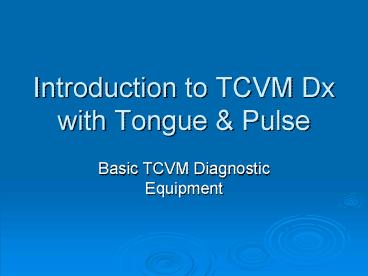Introduction to TCVM Dx with Tongue - PowerPoint PPT Presentation
1 / 22
Title:
Introduction to TCVM Dx with Tongue
Description:
Qi & blood are good quality with normal circulation. Zang-fu organs work properly. ... Black (ashen) Normal. Pale Tongue. Wet is Qi deficiency. Dry is Blood Deficiency ... – PowerPoint PPT presentation
Number of Views:61
Avg rating:3.0/5.0
Title: Introduction to TCVM Dx with Tongue
1
Introduction to TCVM Dx with Tongue Pulse
- Basic TCVM Diagnostic Equipment
2
OVERVIEW OF TCVM
- Health and disease
- Health the natural state, everything in balance.
- Based on energetic physiology
- Qi blood are good quality with normal
circulation - Zang-fu organs work properly.
3
OVERVIEW OF TCVM
Health Qi blood are good quality with normal
circulation. Created by Spleen absorbs Qi from
food and liquid Digestion Lung absorbs energy
from the air. Oxygen Kidney stores
constitutional energy. Adrenal Zang-fu organs
work properly. Lung Large Intestine Kidney Uri
nary Bladder Liver Gall Bladder Heart Small
Intestine Spleen (Pancreas) Stomach
4
Disease Imbalanced symptoms too much
heat, cold, damp, dry, etc. Qi and blood poor
quality Qi and blood circulation impaired One
or more of the zang-fu is not working well
5
Cause of Disease Environment and climate stress
6 pathogen qi Wind Fire/Heat Cold Summer
Heat Damp Dryness Emotional stress 7
emotions Joy/Fright --------gt
Heart Anger --------gt Liver Sadness/Grief ------
--gt Lung Worried -------gt Spleen Fear/Shock -----
--gt Kidney Life Style (Diet, daily
activity) Others Toxins (micro-organisms virus,
bacteria, protozoa)-Heat Toxin Poison Trauma
6
Organization Format to Pathophysioloty 1) Eight
Principles Yang Yin Hot Cold Exterior In
terior Excess Deficiency 2) Six Stages of
Wind Invasion (epidemics by microorganisms) Taiya
ng Surface, skin Shaoyang Half interior, half
exterior (lymph) Yangming Qi level high
fever Taiyin Lung, spleen Shaoyin Kidney,
heart Jueyin Pericardium (CVD), liver
7
3) Four Levels of Heat Invasion (microbe
epidemics) Wei superficial, initial stage,
exterior Qi meridians Ying nerve
systems Blood internal organs 4) Zang Fu
syndromes (internal diseases) Heart Cardiovascu
lar, Central Nervous System, mental Lung Respira
tory, skin, immune Spleen Alimentary tract,
immune, muscular, endocrine, metabolic Liver Hep
atobiliary, eyes, endocrine, metabolic,
ligaments and tendons, hooves/paws KidneyRep
roductive, renal, bone and joints, endocrine,
and metabolic 5) Channel pathologies (arthritis,
trauma, paralysis)
8
- Diagnosis
- Pulse depth, width, height, force, quality
- Tongue pathological presentations
- Shapes, body colors, coat colors, coat textures
- Looking (shen/skin, shapes, eyes, face)
- Smelling (skin, breath)
- Listening (voice, respiration)
- Symptoms and history
9
- Five step methodology
- Signs/symptoms (patients presentation)
- Diagnosis (Name of disease, western diagnosis)
- Each disease has 1 to 10 differentiations
- TCM diagnosis (pattern differentiation)
- Treatment Strategy
- Based on the differentiation
- Energetic pathophysiology
- Treatment (herbs or acupuncture)
10
Normal Tongue
- Pink
- Red
- White
- Blue
- Moist
- Fits mouth
- Good tone
11
Tongue Changes- -Color
- Pale Pink
Red
12
Tongue Changes- -Color
- Purple
- Dark Red
- Black (ashen)
- Normal
13
Pale Tongue
- Wet is Qi deficiency
- Dry is Blood Deficiency
Wet, Swollen (teeth marks) purple is Yang
deficiency
14
Red Tongue
Deficiency
Excess
- HEAT
15
Purple Tongue
Deficiency
Excess
Yang Deficiency Stagnation
Cold
16
Tongue-Organ Relationship
Kidney
Liver
Spleen
Lung
Heart
17
Tongue Coatings
Not as important in animals nor as prominent
- White Coating
- Normal
- Excess Cold
- Yellow Coating
- Heat
- Greasy Coating
- Cant be Scrubbed off
- Damp
18
Pulses
19
Pulse Depth
20
Pulse Character
21
Abnormal Pulses
- Slippery
- Damp
- Like being in a bog
- Wiry
- Liver Stagnation
- Tight like a wire
- Irregular
- Heart Qi or Blood
- arrhythmia
22
Using Tongue Pulse
- Pulse looks at current events
- Tongue reflects history
- Together, they help determine the nature,
location and Zang-Fu involvement in the disease
process































